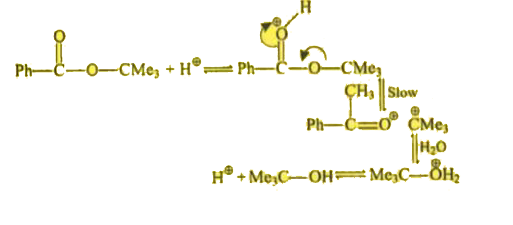Which of the following expression is not applicable on the hydrolysis equilibrium :
CN−H2O⇒HCN+OH−
Kh=KwKa(HCN)
h=√KhC
pH=12pKa(HCN)
[H+]=√Kw.KaC
The correct Answer is:3
To determine which expression is not applicable to the hydrolysis equilibrium of the cyanide ion (CN⁻), we need to analyze the hydrolysis reaction and the relevant equilibrium expressions.
1. Identify the Hydrolysis Reaction:
The hydrolysis of the cyanide ion can be represented as:
CN−+H2O⇌HCN+OH−
This indicates that the cyanide ion reacts with water to produce hydrocyanic acid (HCN) and hydroxide ions (OH⁻).
2. Understand the Nature of CN⁻:
The cyanide ion (CN⁻) is a conjugate base of the weak acid HCN. Therefore, it will undergo hydrolysis in water, making the solution basic due to the production of OH⁻ ions.
3. Equilibrium Constant Expression:
The equilibrium constant (K_h) for the hydrolysis reaction can be expressed as:
Kh=(HCN)(OH−)(CN−)
4. Relationship Between K_h, K_a, and K_w:
For the hydrolysis of a weak acid's conjugate base, the relationship between the hydrolysis constant (K_h), the acid dissociation constant (K_a) of HCN, and the ion product of water (K_w) is given by:
Kh=KwKa
This relationship is valid at a specific temperature.
5. pH Calculation:
The pH of a solution containing a salt of a weak acid and a strong base can be calculated using the formula:
pH=12pKa+12pKw+12logC
where C is the concentration of the salt.
6. Identifying the Incorrect Expression:
Based on the relationships and expressions derived, we need to identify which of the provided options does not conform to the established principles of hydrolysis equilibrium.
- If any expression contradicts the relationships stated above, particularly those involving K_h, K_a, and K_w, or the pH calculation, it would be the incorrect one.
Conclusion:
After analyzing the expressions, the one that does not conform to the established principles of hydrolysis equilibrium is the one that inaccurately represents the relationship between K_h, K_a, and K_w or misrepresents the pH calculation.
The hydrolysis of the cyanide ion can be represented as:
CN−+H2O⇌HCN+OH−
This indicates that the cyanide ion reacts with water to produce hydrocyanic acid (HCN) and hydroxide ions (OH⁻).
The cyanide ion (CN⁻) is a conjugate base of the weak acid HCN. Therefore, it will undergo hydrolysis in water, making the solution basic due to the production of OH⁻ ions.
The equilibrium constant (K_h) for the hydrolysis reaction can be expressed as:
Kh=(HCN)(OH−)(CN−)
For the hydrolysis of a weak acid's conjugate base, the relationship between the hydrolysis constant (K_h), the acid dissociation constant (K_a) of HCN, and the ion product of water (K_w) is given by:
Kh=KwKa
This relationship is valid at a specific temperature.
The pH of a solution containing a salt of a weak acid and a strong base can be calculated using the formula:
pH=12pKa+12pKw+12logC
where C is the concentration of the salt.
Based on the relationships and expressions derived, we need to identify which of the provided options does not conform to the established principles of hydrolysis equilibrium.
After analyzing the expressions, the one that does not conform to the established principles of hydrolysis equilibrium is the one that inaccurately represents the relationship between K_h, K_a, and K_w or misrepresents the pH calculation.
Topper's Solved these Questions
Similar Questions
Knowledge Check

Which of the following will give the racemised product on hydrolysis in presence of H2SO4 ?A B
B C
C D
D
Which of the following best describes the nucleophilic addition step in the acid catalyzed hydrolysis of acentonitrile (CH3CN) ?
A B
B C
C D
D
Which of the following are partial hydrolysis gives XeOF2.
View SolutionWhich of the following can be obtained by hydrolysis of XeF2?
View SolutionWhich of the following gives H2O2 on hydrolysis ?
View SolutionWhich of the following is third member of CnH2n−2 homologous series ?
View Solution4. Which one of the following compounds does not given C2H5Cl by the reaction of C2H5OH?
View SolutionWhich one of the following will give racemised product
in C2H5OH ?
View Solution
